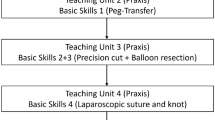Abstract
Introduction
Natural orifice transluminal endoscopic surgery (NOTES) is a multidisciplinary surgical technique. If conventional endoscopic instrumentation can be easily mastered, surgeons with laparoscopic experience could head NOTES interventions.
Materials and Methods
Thirty individuals were tested for endoscopic dexterity. Group 1 included seven gastroenterologists, group 2 included 12 laparoscopically experienced surgeons lacking endoscopic experience, and group 3 included 11 interns who had no hands-on endoscopic or surgical experience. Each individual repeated an easy (T1), medium (T2), and difficult (T3) task ten times with endoscopic equipment on a NOTES skills-box.
Results
Group 3 had significantly poorer performances for all three tasks compared to the other groups. No significant differences were seen between groups 1 and 2 for T1 and T2. The initial T3 performance of group 1 was better than that of group 2, but their performance after repetition was not statistically different. Groups 2 and 3 improved significantly with repetition, and group 2 eventually performed as well as group 1.
Conclusions
The data indicate that laparoscopic surgeons quickly learned to handle the endoscopic equipment. This suggests that a lack of endoscopic experience does not handicap laparoscopic surgeons when performing endoscopic tasks. Based on their knowledge of anatomy and the complication management acquired during surgical education, surgeons are well equipped to take the lead in interdisciplinary NOTES collaborations.





Similar content being viewed by others
References
Kalloo AN, Singh VK, Jagannath SB, Niiyama H, Hill SL, Vaughn CA, Magee CA, Kantsevoy SV. Flexible transgastric peritoneoscopy: a novel approach to diagnostic and therapeutic interventions in the peritoneal cavity. Gastrointest Endosc 2004;60:114–117.
Ponsky JL. Endoluminal surgery: past, present and future. Surg Endosc 2006;20(Suppl 2):S500–S502.
Rattner DW, Hawes R. What is NOSCAR? Surg Endosc 2007;21:1045–1046.
EURO-NOTES Foundation. Endoscopy 2008;40:450.
Ponsky JL. Gastroenterologists as surgeons: what they need to know. Gastrointest Endosc 2005;61:454.
Hazey JW, Narula VK, Renton DB, Reavis KM, Paul CM, Hinshaw KE, Muscarella P, Ellison EC, Melvin WS. Natural-orifice transgastric endoscopic peritoneoscopy in humans: initial clinical trial. Surg Endosc 2008;22:16–20.
Marescaux J, Dallemagne B, Perretta S, Wattiez A, Mutter D, Coumaros D. Surgery without scars: report of transluminal cholecystectomy in a human being. Arch Surg 2007;142:823–826.
Rao GV, Reddy DN, Banerjee R. NOTES: human experience. Gastrointest Endosc Clin N Am 2008;18:361–370.
Zornig C, Mofid H, Emmermann A, Alm M, von Waldenfels HA, Felixmuller C. Scarless cholecystectomy with combined transvaginal and transumbilical approach in a series of 20 patients. Surg Endosc 2008;22(6):1427–1429.
Zorron R, Filgueiras M, Maggioni LC, Pombo L, Lopes CG, Lacerda OA. NOTES transvaginal cholecystectomy: report of the first case 1. Surg Innov 2007;14:279–283.
Vosburgh KG, San Jose ER. Natural orifice transluminal endoscopic surgery (NOTES): an opportunity for augmented reality guidance. Stud Health Technol Inform 2007;125:485–490.
Aggarwal R, Tully A, Grantcharov T, Larsen CR, Miskry T, Farthing A, Darzi A. Virtual reality simulation training can improve technical skills during laparoscopic sal**ectomy for ectopic pregnancy. BJOG 2006;113:1382–1387.
Grantcharov TP, Bardram L, Funch-Jensen P, Rosenberg J. Learning curves and impact of previous operative experience on performance on a virtual reality simulator to test laparoscopic surgical skills. Am J Surg 2003;185:146–149.
Swanstrom L, Zheng B. Spatial orientation and off-axis challenges for NOTES. Gastrointest Endosc Clin N Am 2008;18:315–324.
Author information
Authors and Affiliations
Corresponding author
Additional information
No grant support for this project.
Rights and permissions
About this article
Cite this article
Wagner, O.J., Hagen, M., Morel, P. et al. Who Should Do NOTES? Initial Endoscopic Performance of Laparoscopic Surgeons Compared to Gastroenterologists and Untrained Individuals. J Gastrointest Surg 12, 1724–1729 (2008). https://doi.org/10.1007/s11605-008-0649-x
Received:
Accepted:
Published:
Issue Date:
DOI: https://doi.org/10.1007/s11605-008-0649-x




